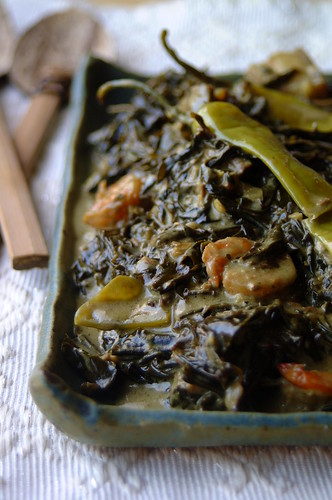
I fell in love in Bicol.
During my visit there last year, my friend K and I fell madly in love with the region’s culinary trifecta – Laing, Bicol Express, and Pinangat. All three dishes proudly bearing the two elements that Bicolano food is famous for – gata (coconut milk) and chili. Our kind hosts would valiantly try to make us eat other dishes, but we were having none of it. Really, it was unusual for us to have blinders on when it comes to food, but we could not see beyond those three dishes, devouring them with an almost angry passion. And K doesn’t even care for food that is too spicy! How do you explain that?
To this day K and I keep our eyes and noses on red alert for fine Bicol fare. We text message each other fervently when we chance on something promising and do many taste tests. When K’s nose and palate sense a good find you will hear her say softly and sweetly, “Hello friend!”
Bicolano food has me whipped good and proper. It has wound its coconut milk and chili tentacles around me and refuses to let go. And I’m not struggling.
I’m making my own.
Laing (pronounced lah-ing)
(adapted from Flavors of the Philippines by Glenda Rosales-Barretto)
- 100-150 grams “dried laing” (dried gabi/taro leaves)
- 250 grams pork belly, boiled for 5 minutes and diced
- 200 grams shrimp, shelled and deveined
- 1 onion, chopped
- 2 1/2 tablespoons chopped ginger
- 125 grams bagoong alamang (shrimp paste)
- 50-60 grams long green chilis (sili pangsigang), depending on how spicy you want it, half cut in two, half left whole
- Freshly ground black pepper
- 1 liter coconut milk
- 400 ml coconut cream
- In a bowl, mix the pork, shrimp, onion, ginger, bagoong, the cut-up chilis, and the coconut milk. Pour this into the pot, over the leaves, and season with freshly ground black pepper.
- Bring to a boil, then reduce heat and simmer for 30 minutes. Don’t stir…just press down on the leaves every once in a while so it soaks up the liquid.
- Add the whole chilis and the coconut cream and simmer for 5-10 minutes. Stir gently to make sure all is incorporated without mashing the leaves too much.
I based my recipe on the one found in Flavors of the Philippines by Glenda Rosales-Barretto…which incidentally (drum roll please) is my very first Filipino cookbook! I love cookbooks, but when it comes to Filipino food, relatives and friends seem to be much better sources of recipes than any book could. But it bothered me that I didn’t own even one local cookbook, so with the recommendation of a friend, I chose this one. I like it because it has a little bit from each region – Bicol included (yay!). I’ll be exploring more of this book soon :)
Glenda (first name basis already!) uses fresh gabi leaves and stalks, but I used dried (you can find this in the groceries labeled as “dried laing” or “dried gabi”). If you want to see fresh gabi leaves check here. I used the dried version because, aside from it being easier to find, fresh gabi leaves require special handling…or else they make your throat itch like the devil! I know this firsthand. Imagine thorns suddenly sprouting on the inside of your throat. You get the idea. Dried gabi leaves for me, thank you. I also used less chilis than in the original recipe and didn’t add any sili labuyo (our oh-so-spicy bird’s eye chili). This will make a fairly mild laing with just a touch of spice. Add more chilis, or use sili labuyo, to increase the heat.
Of course, K is the first person I text message when I see my brew starting to resemble the laing we know and love. I have a big batch, so I can give her a fair amount of takeaway. She comes over as soon as work is done with hot, steaming rice in tow and sits down to try my first ever laing.
Hello friend! :)
This is my entry to Lasang Pinoy 24: Loco over Coco hosted by Kai of Bucaio. I’m late! But I couldn’t miss this round…I love coconuts! :)